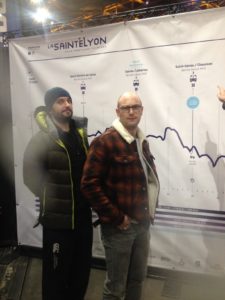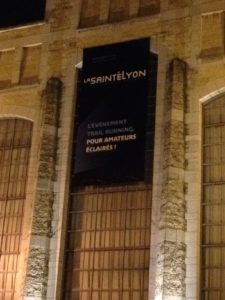Planning/Organisation

The team surveys the route at the Hall Tony Garnier
The SainteLyon event website is a fairly tricky beast to navigate, partly due to the fact it has both a French and English version (with significant differences between the two), and partly due to some clunky functionality. So initially it was fairly tricky to establish what the relay 4 actually entailed and how, practically, it was to be achieved. However, once you find your way to the right spot the information is provided in good detail – particularly if you are able to digest the French version. Even better (largely because it’s all in one place) is the event handbook, which can be downloaded as a PDF. Finding the right point of information will tell you that the relay distances and locations are as follows:
Leg 1: 16Km between Saint Etienne and Soucieu en Jarrest
Leg 2: 12Km between Soucieu en Jarrest and Sainte Catherine
Leg 3: 23Km between Sainte Catherine and Saint Christo
Leg 4: 21Km between Saint Christo and Lyon
See below on how we shuttled between these points, depositing/picking up runners.

The team – L’equipe Morse Coquin 2016
Signing Up + Medical Certificates
Once you’ve established that the Sainte Lyon is indeed the sort of undertaking you’re keen on and done the inevitable soul-searching and grimacing at your bank account that these things always entail, signing up and paying is relatively straightforward and the login area/portal for your application easy to use. One point of difficulty for foreign racers (or those from the UK at any rate) is the requirement to provide a medical certificate to the organisers in order to compete – a practice that is common in France but not in the UK. You can sign up/pay without one but will need to upload it prior to taking part.

The author in full gear
You essentially have two options: 1) Go to your GP and sort one out. 2) Pay this service online to do it for you. The key point to remember in order for your certificate to be valid is that it must specify that you are fit to take part in a running event. Suggested wording is as follows:
Once all your details and medical certificate are uploaded, you’re good to go. Changing and adjusting details is fairly easy within the organisers’ portal, while any large changes can be made by emailing the Sainte Lyon support address ([email protected]). We changed one of our team members the week before without any difficulty.
Registration and Exhibition Centre – Halle Tony Garnier, Lyon
We arrived mid-afternoon on the day before the event, and the sheer scale of the event strikes you even before you get into the Halle Tony Garnier due to the intensity of traffic around the Halle as participants come to register. Worth getting there by other means than car (tram/bus) if you can, though we managed to find a space relatively close by (10 mins walk).

Once you’re through security and in the exhibition centre, it’s pretty immense – hundreds of stalls, big screens, tiered seating by the finish, free food (cheese, bread, salami – very Francais!) from the various stands, and photos/tales from previous editions of the event. It got our adrenalin pumping and created some real excitement. At the back of the hall we got our race info packs and registered – all very quick and straightforward.

Roman prepares himself mentally
Getting to the Salle Expo in Sainte Etienne
It took us about an hour to get there from the centre of Lyon in our hire car. Coaches also go from the Halle Tony Garnier throughout the evening if you aren’t using a hire car (though you really need a car to do the Relay 4). Again, the scale of the event is breathtaking – effectively there are two hangars packed with people in various states of preparation. Some sleeping, some stretching, some greasing their legs and other vital areas. The pasta party provided a good feed of hot pasta, fruit and bread. Queues for the toilets were dramatic so be warned.
Getting to / from Relay Points
Our plan was to drive to Sainte Etienne from Lyon and use our hire car to get between relay points, picking up and depositing runners as we went along. The only possible hitch was that we were told cars were forbidden from St Catherine and that the only option was to take the coach from and to there, but as that would have meant us splitting up as a team we banked on us being able to get close enough to the checkpoint in a car, even if it meant a couple of extra kilometres for runner 3. In the end, this worked out just fine and plenty of people were doing it – a long line of parked cars stretched from the edge of the ‘forbidden zone’ and marshalls were there directing people to the start. So our drop off/pick up shuttle plan worked just fine and was straightforward with the sat nav – all we needed to do was plug in the name of the village/town into the sat nav and it would take us there, with marshalls and signs to direct us to exactly where we needed to go. Easy! Worth bearing in mind that the drive can be very cold and very foggy – so leave plenty of time between the checkpoints. But at no point did we struggle to make it on time. Once we reached each relay point car park one person + the runner would get out and head down to the actual handover zone (well signed and lit).
The Run Itself
One word – thrilling! On a mixture of road, track, mud and ice (and everything in between), the various legs snake through the French countryside. The start of the first leg and substantial parts of the last leg are on roads as you go out of Sainte Etienne and into Lyon, while the middle legs are largely cross country. The other key difference is that at the start runners are very close together (creating an immense spectacle of thousands of head torches floating in the night, as you’ll see at the relay points), while at the end they are much more spread out – at times I couldn’t see any other runners. The key point here is that it is essential to have a high quality head torch; worth spending extra on this. Some of the tracks/paths are treacherous with roots, rocks, holes and steps, so it is crucial to be able to see your footing if you want to go at any sort of pace.
Worth the Travel/Expense?
Those of us who did the longer legs were unanimous in our agreement that yes, it was worth it. The two shorter-legged runners were mixed in their feedback. Setting off on the first leg was deemed an awesome experience, surrounded by thousands of other athletes in the middle of the night. Our first runner, Roman Sea Pelican, felt it may have been a little short for the expense and admin involved in the trip, but this was primarily due to the extra £200 paid for the Eurostar having missed his flight. The second runner was a little more dubious, running a mere 12K after a good deal of admin and organisation, not to mention sleeplessness and a long time spent in the back of a vehicle, but felt that overall it was worth it. The overall message may be to ensure you make a weekend of it – spending a couple of days in Lyon (which is a fantastic city) – in addition to the race, as opposed to our ‘smash and grab’ affair.
Summary
An exciting, unique event that we would highly recommend. Something to keep the legs burning in the middle of winter!

Wetbeak and Haddock eagerly await departure
